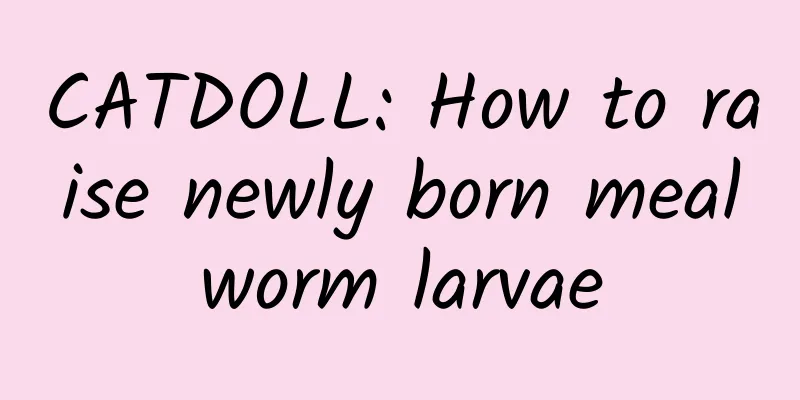CATDOLL : CATDOLL: How to raise newly born mealworm larvae

|
1) Seed worms The most important thing in raising mealworms is to have seed worms. Adult larvae, pupae, and adults can all be used as seed worms. When they are raised to different stages, carefully select pupae and adults according to the breeding technology of mealworms, remove diseased insects, screen eggs, and make each stage reproduce synchronously to achieve purification and rejuvenation. After buying adult larvae, put them in a wooden tray filled with wheat bran and feed them with fresh vegetables. Carefully observe the pupation situation, put the sieve tray in the wooden tray filled with feed, and wait for the pupae to emerge into adults. If you also buy pupae at this time, put them together with the pupae that have emerged within two days. Put every 0.5 kg of pupae in a sieve tray filled with wheat bran, and then put them in a wooden tray filled with feed, number them and put them on the shelf, wait for them to emerge, and pay attention to removing dead pupae. For example, if you buy adults, put them in a sieve tray filled with feed, and screen out the adults and change the tray every 7 days. The sieved feed is mixed with eggs, which are placed in a wooden tray and continue to hatch. Insects of all stages that have been carefully selected and raised can be used as breeding insects, but it is best to use adult larvae as breeding insects. (II) Feed The main feed for mealworms is wheat bran, which can also be supplemented with bran (cornmeal is too fine and airtight, so it cannot be used as mealworm feed). Vegetables are mainly cabbage, radish, cabbage and other leafy vegetables. These feeds can meet the insect's needs for protein, vitamins, trace elements and water. In order to purify and rejuvenate the population and accelerate reproduction and growth, a small amount of glucose powder, fish meal, etc. can be added to the feed. Every 0.5 kg of mealworms can eat 1.5 kg of wheat bran and 3 kg of vegetables in one generation cycle. (III) Equipment 1. You must have a breeding room to breed mealworms. The breeding room must be light-permeable and ventilated, and it must be heated and insulated in winter. The size of the breeding room depends on the number of mealworms to be bred. Generally, 300-500 trays can be raised in a room of 20 square meters. 2. The wooden tray for feeding mealworms is made of drawer-shaped wooden trays, which are generally rectangular, with specifications of 50 cm long, 40 cm wide and 8 cm high. The board thickness is 1.5 cm, and the bottom is nailed with fiberboard. The sieve tray is also rectangular, and it should be placed in the wooden tray. The specifications are 45 cm, 35 cm and 6 cm. The board thickness is 1.5 cm, and the bottom is nailed with 12-mesh iron sieve and three-ply board strips. The wood for making the feeding tray is preferably soft miscellaneous wood, and it has no peculiar smell. In order to prevent the worms from crawling out, plastic strips should be attached to the four frames of the feeding tray. 3. Place the wooden rack for feeding trays. Make wooden racks according to the feeding amount and the number of feeding trays. Use square wood to connect and fix the wooden racks to prevent them from tilting or falling. Then you can place the feeding trays on the racks in order. 4. The sieve plates and sieves can be made of iron sieves of different sizes. The 12-mesh large-hole sieve can screen insect eggs. The 30-mesh medium-hole sieve can screen insect feces. The 60-mesh small-hole sieve can screen 1-2 instar larvae. 5. The temperature inside the breeding room should be kept between 15-25 degrees Celsius in both winter and summer. If the temperature is below 10 degrees Celsius, the insects will not eat or grow. If the temperature is above 30 degrees Celsius, the insects will burn to death due to heat. The humidity should be kept between 60-70%, and the ground should not be too wet. Heating should be provided in winter. If no breeding is done in winter, the insects can overwinter naturally. Ventilation should be provided in summer. A thermometer and a hygrometer should be prepared indoors. 2. Breeding Technology Describe them in order according to the insect stage. (I) The process of pupae emerging from adults takes about 3-7 days. The head, chest, legs, and wings emerge first, and the abdomen and tail emerge later. Because the pupae are selected for emergence at the same time, they can all be completely emerged within a few days. The newly emerged adults are very tender and not very active. After about 5 days, the body color becomes darker and the elytra become hard. Male and female adults usually gather in the dark when mating, and the mating time is relatively long. When laying eggs, the tail of the female insect is inserted into the sieve hole to lay eggs. It is best not to stir it at will during this period. When a layer of eggs is found attached to the bottom of the sieve plate, the plate can be changed. At this time, the adult insects are screened and placed in another plate containing feed, and the dead insects are removed. The egg plate is changed every 5-7 days. The survival period of adults is about 50 days. Adults in the egg-laying period need a lot of nutrition and water, so wheat bran and vegetables must be added in time, and fish meal can also be added. If the nutrition is insufficient, the adults will bite and kill each other, causing losses. (ii) Egg stage adults lay eggs in a wooden tray containing feed. Replace the wooden tray with eggs and put it on the shelf. Larvae will hatch naturally. Pay attention to observation and do not turn it over to avoid damaging the eggs or the hatching larvae. When larval skin appears on the surface of the feed, the first instar worm has been born. (III) Larval stage The period from egg hatching to larvae and before pupation is called the larval stage, and larvae of all ages are the best feed for Chinese forest frogs. The tray where the adults lay eggs, after 7-9 days of hatching, when the molted body is more than 0.5 cm long, add wheat bran and fresh vegetables. Put 1 kg of larvae in each wooden tray. The density should not be too large to prevent the larvae from biting and killing each other due to insufficient feed and squeezing. As the larvae grow up, separate the trays in time. Wheat bran is the main feed for larvae and also their habitat. Therefore, the feed should be kept at a natural temperature. Under normal circumstances, when the temperature is high, the larvae are mostly active on the surface of the feed, and when the temperature is low, they burrow into the lower layer to live. The thickness of the feed in the wooden tray should be within 5 cm. When the feed gradually decreases, use a sieve to sift out the insect feces and add new feed. When sieving feces for 1-2 instar larvae, a 60-mesh sieve should be used to prevent the larvae from leaking through the sieve holes. Prepare a wooden tray for the new feed first, and put the sieved clean larvae on the wooden tray while sieving. Mealworm larvae need to break through the outer skin (shedding) to grow, and they can only grow up after molting again and again. During the larval stage, they molt 7 times. Each time they molt, the worm grows bigger and the larva grows one year old. They molt once every 9 days on average. When the larvae molt, the epidermis first splits from the thoracic and dorsal seams, and the head, thorax, feet, and then the abdomen and tail gradually molt out. Larvae usually molt on the surface of the feed, and after molting, they drill into the feed. The larvae that have just molted are milky white and have a delicate epidermis. (IV) Larvae in the pupal stage pupate on the surface of the feed. Before pupation, the larvae crawl to the surface of the feed, lie still, and then slowly expand and contract. During the last molting, the larvae pupate. The pupation can be completed within a few seconds. The newly formed pupa is white-yellow, with a slightly longer body and wriggling abdominal segments. Gradually, the body shortens and turns dark yellow. There are differences between individual larvae, which are reflected in the order of pupation time and the strength of individual abilities. Pupae that have just emerged and are mixed with larvae in a wooden tray are easily bitten by the larvae in the chest and abdomen, and their internal organs are eaten, becoming empty shells; some pupae are infected with viruses during the pupation process and become dead pupae after pupation. This requires frequent inspection. If this is found, the space can be sprayed with 0.310-6 bleach solution to disinfect and sterilize. At the same time, the dead pupae should be picked out and disposed of in time. When picking pupae, pupae that have emerged within 2 days should be placed in the same sieve tray containing feed, and synchronous reproduction should be insisted on, and concentrated to emerge as adults. The newly hatched mealworm larvae are about 3 mm long and milky white. After one day, the body color turns yellow. The body has 13 segments and is cylindrical, with the head located at the front of the body segment. The mouthparts are flat and chewing, and can chew harder food. The 2nd to 4th segments are the thorax, with 3 pairs of legs, the 5th to 12th segments are the abdomen, and the 13th segment has an anus at the bottom and two short conical tails at the tip. Wheat bran is the main food for larvae and also their habitat. Therefore, the feed should be kept at a natural temperature. Under normal circumstances, when the temperature is high, the larvae are mostly active on the surface of the feed, and when the temperature is low, they burrow into the lower layer to live. The thickness of the feed in the wooden tray should be within 5 cm. When the feed gradually decreases, use a sieve to remove the insect feces and add new feed. (1) When the larvae can be clearly seen with the naked eye, they should be heated and humidified to promote their growth and development. The temperature can be increased by increasing the density. Humidification is to sprinkle water into the feeding box regularly (6-8 times a day). However, the amount should be small and no visible water should appear. Adding more water to the feed can also increase humidity. (2) Feed the larvae with nutritious feeds No. 1, 3, and 5, and give them plenty of green feed. (3) It is best to raise large and small larvae separately to avoid leftover food. (4) The suitable temperature during this period is 25-32℃, humidity is 60%-75%, and bran humidity is 10%-15%. Don't keep it anymore, feed it to the birds or fish. |
<<: CATDOLL: How do you take care of a small spider you caught at home?
>>: CATDOLL: The best way to kill flies in pig farms How to deal with flies in pig farms
Recommend
CATDOLL: How to feed hairy crabs
How to feed hairy crabs 1. Water quality regulati...
CATDOLL: How to add eyes to chickens? A complete guide to chicken eye implant surgery
introduction In the field of biological research,...
CATDOLL: What do cockroach, mantis, and dung beetle mean?
What do cockroach, mantis, and dung beetle mean? ...
CATDOLL: Origin and season of Chinese round field snails
Origin and production season of Chinese round fie...
The largest cat in the world
The largest cat in the world is the Maine Coon, w...
CATDOLL: Is there any special medicine to treat snails?
1. Ants and snails have become a plague. What pes...
CATDOLL: Silver carp farming is very popular. What are the requirements for silver carp farming?
Silver carp farming is very popular. What are the...
CATDOLL: Can people with ulcerative colitis eat soft-shelled turtle?
Can people with ulcerative colitis eat soft-shell...
Can cats take a bath in winter?
Cats can take a bath in winter. The temperature is...
CATDOLL: A complete collection of high-definition pictures of raising grasshoppers in greenhouses (a complete collection of high-definition pictures of raising grasshoppers in greenhouses)
1. What are the costs and profits of one acre of ...
CATDOLL: How much soil should be put in to raise earthworms (How much soil should be put in to raise earthworms)
1. How thick is the soil needed for raising earth...
CATDOLL: How many days do earthworms need to be raised before they can be marketed? (How many days do earthworms need to be raised before they can be marketed?)
1. How long does it take to produce finished prod...
CATDOLL: How to keep red worms alive longer (How to keep red worms alive longer)
1. Tips for keeping red worms alive for 60 days? ...
CATDOLL: Which month is suitable for stocking fish fry?
1. Which month is suitable for releasing fish fry...
CATDOLL: How many trees should be planted per acre to raise cicadas? (How many trees should be planted per acre to raise cicadas?)
1. How many willow trees should be planted per ac...









